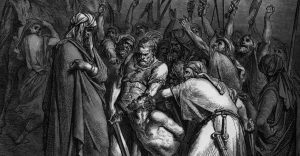N. T. Wright continues his prolific contribution to New Testament studies with an extensive focus on the meaning of Christ’s death. It is written for a broad readership, rather than for academics. In it we find many familiar Wright themes, here used with specific attention to this one subject. The great strength of Wright’s approach is his work on uncovering the coherence and resonances of the big Bible story, and of showing how narrative both expresses and reflects this larger picture. I particularly value his constant attention to God’s people and to our responsibility for God’s world. This is a valuable correction to solely individualistic interpretations of the gospel of Christ.
I have some sympathy for some of his frustrations. How many series on Romans end with chapter 8, while chapters 9-16 are ignored! And how often the application of Romans 1-8 is personal assurance of salvation, or the need for right doctrine, or the key to the Christian life. Individualism often distorts our reading of the Bible, and our preaching and teaching of the Bible.
His final moving section on the sufferings of the church is excellent, and an apt message for the church in the West, as it is for the church in the 2/3rds world.
However, his positive aim of showing us the meaning of Christ’s death is undermined by his constant critique of the traditional doctrine of the death of Christ as our substitute undergoing God’s punishment for sin on behalf of sinners. He does this in the broader context of a sustained and extensive attack on ‘a platonic view of the ultimate goal’ (‘heaven’), a moralistic view of the human vocation (‘good behaviour’), and a downright pagan view of salvation (an innocent death placating an angry deity).’ (311) There is no interaction with Christian tradition or scholarly views which hold traditional nuanced interpretations of penal substitution, but an attack on what he perceives as the common preaching and teaching on the atoning death of Christ in evangelical circles. It is an intentionally divisive book, and its criticisms are harshly expressed. It reflects an academic impatience with those of less theological ability, and a reaction against perceived errors which runs the risks of falling into opposite errors!
It is an unfortunate feature of the book that other views are pilloried, and given the worst possible interpretation. So, the traditional view of penal substitution is constantly portrayed as an angry Father venting his anger on his innocent Son. He damns the traditional doctrine of penal substitution by constantly referring to it as pagan and capricious: ‘paganising ‘angry God punishing Jesus;’’ (234) ‘divine petulance;’ (224) ‘Capricious, or malevolent divinity longing to kill someone, and happening to light upon a convenient innocent victim;’ (232) ‘rescue this substitution from its pagan captivity;’ (287) ‘an arbitrary and abstract ‘punishment’ meted upon an innocent victim;’ (337) ‘the paganised vision of an angry God looming over the world and bent on blood.’ (349) Guilt by association is rhetorically effective, but intellectually weak. He is attacking a straw person. As GK Chesterton observed: ‘Any stigma to beat a dogma.’
Wright then opposes this pagan view with the not-so-novel idea of God’s love expressed in Christ: ‘not an angry father lashing out at an innocent and defenceless son, but … someone embodying the love of God.’ (201) One might have thought that the popularity of John 3:16 in evangelical circles would have reassured Wright that his fears are not justified. He writes, ‘we do not find a wrathful God bent on killing someone… Instead we find the image … of a covenant-keeping God who takes the full force of sin onto himself.’ (185) That sounds just like John Stott’s memorable phrase, ‘the self-substitution of God.’[1] Words used to describe the death of Christ by those who are not trained as academic theologians may be unwise and simplistic, but to accuse them of paganism is grossly unfair. Wright does not even mention Christian theologians whose writings defend the Christian tradition of penal substitution, and who make the same point he wants to make—that Christ’s death reveals God’s love. This idea is not new! Calvin, for example, quotes Augustine:
The fact that we were reconciled through Christ’s death must not be understood as if his Son reconciled us to him that he might now begin to love those whom he had hated. Rather, we have already been reconciled to him who loves us, with whom we were enemies on account of sin.[2]
And Calvin himself writes:
The secret love in which our Heavenly Father embraced us to Himself is, since it flows from the eternal good pleasure, precedent to all other causes…The true looking of faith…is placing Christ before one’s eyes, and beholding in Him the heart of God poured out in love.[3]
And Calvin has a carefully expressed view of the relationship between the Father and the Son in the atonement:
How could (God the Father) be angry toward his beloved Son, ‘in whom his heart reposed’? (Matt 3:17). How could Christ by his intercession appease the Father towards others, if he were himself hateful to God?[4]
Christ endured the punishment of God in our place, and the Father delighted in his self-offering, and accepted his sacrifice. Any similarities between some pagan themes and the Biblical view of willing Trinitarian penal substitution do not mean identity of meaning, nor demonstrate derivation.
Wright holds the view that evangelical preaching of the cross has been entirely focussed on ‘getting to heaven when you die.’ I think it is more often focussed on relating to God now, and knowing his love and acceptance. Wright’s negative assessment of evangelical engagement in the world is not justified. At its worst, evangelical Christianity can be solely individualistic, and retreat from involvement with the world. But at its best, evangelicalism has a fine record in planting churches, encouraging people to be prolific in good works, and made a significant contribution to global grass-roots improvements in education, health-care, and evangelism. The historian David Bebbington claims that one of the four characteristics of evangelicalism is ‘Activism:’ sustained and effective service of God in the world.
On Idolatry
Wright’s focus on the significance of the atonement is on Christ’s powerful death breaking the power of idolatry, on defeat of false gods and evil powers. For him, idolatry is our greatest problem: ‘not only sin, but the idolatry that underlies it.’ (68) The disease and the cure are closely linked. However in Romans 1:18ff, both idolatry and sin are the results of a prior and deeper sin, that of suppressing the truth about God and failing to honour him and thank him. The heart of our problem is our relationship with God: our idolatry, our sin, and our failure to serve God is the result of failing to worship God and turning away from him. It is the rupture in our relationship with God which is the cause of other problems, including idolatry and our other internal and external sins. So the restoration of this relationship must be at the heart of the atonement. Wright says that we are mistaken to think that fellowship with God is the goal (74). He is wrong: it is the heart of the problem and so the heart of the solution. Despite his claim to take note of the big Biblical narrative, he has missed the climax of the narrative in Genesis 1-3, as Adam is cast out of the garden. The point is made so clearly in Hebrews, that most extensive New Testament explanation of the atonement. The defeat of Satan and evil powers is present, albeit very briefly (2:14, 10:13). But the climax of the letter is entrance into ‘the most holy place’ by our great priest and his shed blood (10:19-15). In John’s gospel eternal life comprises knowing Jesus and so knowing the Father.
So much contemporary atonement theology focusses on God’s solution to ‘horizontal’ problems: our internal problems, our human relationships, our relationship with evil powers, our duties in the world. These are all significant, but they are the result of the dislocation of our relationship with God, resolved in Christ. Wright’s focus on idolatry is a useful servant, but a bad master. He writes that ‘lawbreaking is a symptom of a much more serious disease … idolatry.’ (77) Actually, lawbreaking and idolatry are terrible because they are aspects of our turning away from, and against, God. The most fundamental problem we have is our broken relationship with him; not the deficiency of the idols we worship in his stead. Wright does acknowledge that ‘humans are made to worship the God who created them,’ (100) but his way of talking about idolatry marginalises that perspective.
Wright is willing to use the traditional words associated with the atonement, namely that it is achieved by the death of a representative, who dies a substitutionary death, and suffers punishment (240-241). He clearly claims that ‘Jesus dies, innocently, bearing the punishment that he himself had marked out for his fellow Jews as a whole.’ (211) However, he is at pains to point out that he uses such words in ways thoroughly distinct from traditional usage. The purpose of Christ’s death is not reconciliation with God. The effects of Christ’s death include the following:
- ‘Taking on himself the scorn, malevolence, and hatred of the world.’ (219)
- ‘Self-giving love turns out to have a power of a totally different sort to that known in the world.’ (253)
- ‘The Messiah’s death ‘for sins’ under the right and proper curse of the law was therefore the necessary means by which victory could be won.’ (245)
- ‘The Messiah’s crucifixion…means the creation…of a single covenantal family.’ (244)
- ‘The answer to human idolatry, the root of sin, is the fresh revelation of the one true God.’ (332)
- ‘The Messiah as the place of meeting, the ultimate revelation of the divine righteousness and love.’ (339)
All this is true: it is what is missing that matters. How did Jesus’ death achieve all this? We know it was revelation, and we know its results. But what did it do?
Wright claims that God did not punish Jesus, but punished sin in Jesus:
Paul does not say that God punished Jesus. He declares that God punishes Sin in the flesh of Jesus. … Equally, it is certainly substitutionary: God condemned Sin (in the flesh of the Messiah), and therefore sinners who are ‘in the Messiah’ are not condemned. (287)
Yet if Christ died ‘under the right and proper curse of the law’ (245), then he died under God’s curse. I know that Paul does not use the phrase ‘cursed by God’ in Galatians 3:13, but whose curse is it? It is God who sends curses to his covenant people in the big biblical narrative (Deut 27-28). To say that Christ ‘bore sin,’ and was ‘made sin’ (1 Pet 2:24, 2 Cor 5:21) is to say that he suffered the consequences of sin. That sin was our sin: he was our substitute. And the most significant problem with sin is that it brings death, which is the judgement of God, and expresses the breakdown of our relationship with God. Christ suffered as our penal substitute.
His desire to avoid the God-ward element of the atonement is also expressed in his view that no Old Testament sacrifices relate to punishment for sin. Instead he claims they are signs of penitence; and blood-sacrifices release the life that is in the blood which then has detergent or cleansing power. So the blood cleanses people, it is not a propitiatory offering to God (329). In my opinion, what Wright affirms is right, but what he denies is wrong. The Old Testament claims atoning power for some of its sacrifices. It is because Christ’s blood is propitiatory that it has the power to forgive and to cleanse. The God-ward meaning of Christ’s death is fundamental.
Israel and the Gentiles
Wright makes it clear that Christ’s death benefits Israel, as he suffers their covenant curse. How then does Jesus’ death help Gentiles? His answer:
The servant will die for the nation, but will thereby do for the world what Israel was called to do but could not do, setting the nations free from their ancient bondage, so that they now can join the single people of God. (212)
While joining the people of God is the privilege of believing Gentiles, this does not explain how Jesus is their saviour. Salvation includes deliverance from the powers of evil, and the power to do good works in the world, but salvation is at heart the forgiveness from the penalty of sin, which is death. It is not clear how Jesus is the Gentiles’ saviour.
Furthermore, while defeating the power of Gentile idols is a wonderful victory, Wright does not clarify how it was achieved. He writes,
Jesus, by taking upon himself the weight of Israel’s sins and thereby of the world’s sins, dies under the accumulated force of evil, so that at last the kingdom can come in its fullness. (217)
But how? Christus Victor is only one aspect of the death of Christ. In the words of Graham Cole,
The good news is that Christ’s cross not only saves us but additionally disarms those forces arraigned against us … The key to the disarmament is the forgiveness of sins on the basis of the cross … Christus Victor needs the explanatory power of substitutionary atonement. (1)
Another unsatisfactory feature of his argument is the forcing of false dichotomies, the artificial creation of unnecessary alternatives. Here is an example:
Not a system but a story; not a theory but a meal and an act of humble service; not a celestial mechanism for punishing sin and taking people to heaven but an earthly story of a human Messiah… (415)
In fact, the New Testament gives us interpretation as well as story, theology as well as enactment; our forgiveness is a heavenly reality (as Hebrews makes clear), and eternal life begins now and continues forever; and while we have an earthly story of a human Messiah, he is also our high priest at the right hand of God. False dichotomies are powerful rhetoric, but do not reflect clear thinking. Similarly, when he writes that Jesus ‘did not give them a theory, a model, a metaphor…he gave them a meal,’ (182) this is another example of simplistic confusion. Yes, Jesus did give them a meal. But his words provided his interpretation of the meal. And elsewhere Jesus spoke of the powerful effect of the words he had spoken to his disciples, and of the power of the truth he had revealed (Jn 17:6-8, 8:31).
Another form of adversarial rhetoric Wright uses is to dismiss others and promote his own enlightenment: ‘(T)he gospels … give (atonement theology) not as a neat little system, but as a powerful, sprawling, many-sided, richly revelatory narrative.’ (415-16) Goodness me! Has no one else ever realised that before? How amazing!
Other issues
There are five other issues that arise from this book, as they do from Wright’s other writings.
- We have learnt that the meaning of words lies in their use, not in their derivation. Does not the same rule apply to the use of images and rites? If so, should we not understand the Old Testament in the light of the New, rather than assuming all Old Testament meaning is carried forward into New Testament meaning? Do we not move from ‘shadow’ to ‘substance’? And similarly, while understanding the Judaistic background of New Testament words and ideas is important, does not their use in the New Testament define their meaning?
- While it is instructive to see the Judaistic background to the New Testament, the New Testament itself interacts most often with the Old Testament itself, not contemporary writings. And in both Jesus and his followers we find a sense of distance from contemporary Jewish thought and especially contemporary Jewish interpretations of the Old Testament. Was not Jewish opposition to Jesus’ Old Testament hermeneutic one reason for his death?
- In Jesus’ parable of the Pharisee and the tax collector (Lk 18:9-14), there is a striking contrast between the self-justification of the Pharisee and the humility of the tax collector. And it is the tax collector who is ‘justified.’ Here justification is not about Jewish-Gentile divisions, but division within God’s people. Is this not 1st Century AD evidence of an unhealthy ‘works-righteousness’ within contemporary Judaism?
- Could not Jesus’ teaching on the water of eternal life and the bread of life in John 4 and 6 be described as a ‘spiritualising’ of these worldly Old Testament images?
- Wright constantly affirms that for the New Testament writers the exile ended with Christ’s death, yet in James 1:1 we read that Christians are still in exile. And he constantly claims that return from exile includes forgiveness of sins. Yet in 1 Peter 1:1-2 we read that believers are still in exile, yet also that they are sanctified by the Spirit and sprinkled with the blood of Christ! These are the only two references to ‘exile’ in the New Testament! Peter refers to the church in Rome as being in Babylon (5:13). And in Revelation the fall of Babylon is yet to happen (Rev 18). Wright’s theory does not deal with all the evidence. Perhaps the Bible narrative is even richer and more nuanced than at first appears?
A thought-provoking book, as you can see!
[1] Graham Cole, God the Peacemaker: How atonement brings shalom, NSBT, Nottingham, Apollos/ Downers Grove, IVP, 2009, 183.
[2] John Stott, The Cross of Christ, Leicester, IVP, 133-163.
[3] John Calvin, The Institutes, 2.16.4, quoting from Augustine, John’s Gospel, cx. 6.
[4] Calvin, Commentary on John, 3:16.















